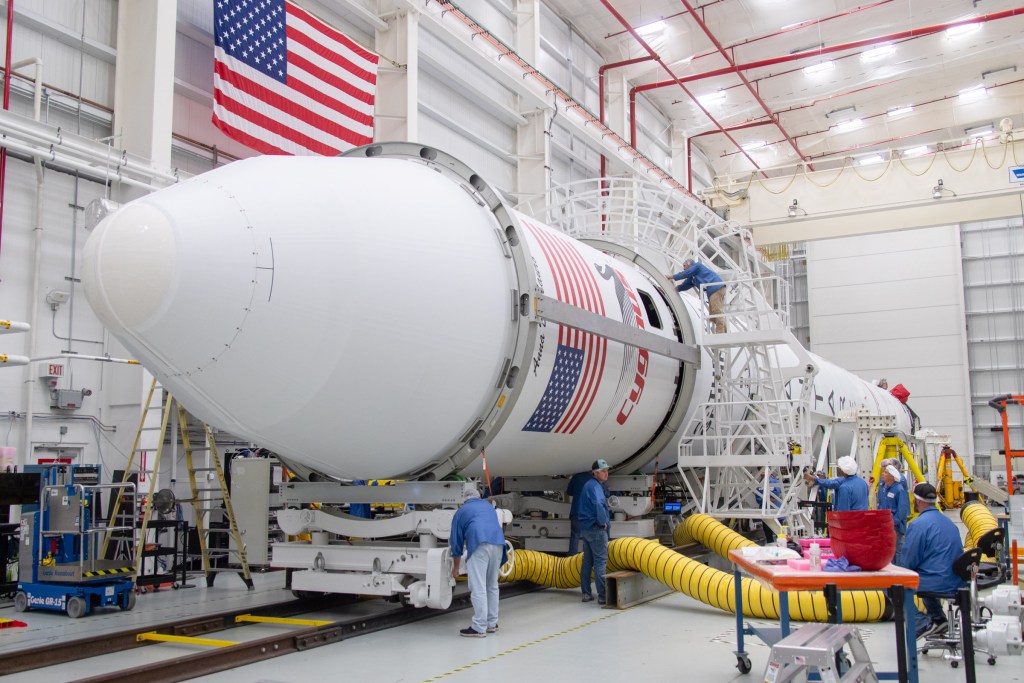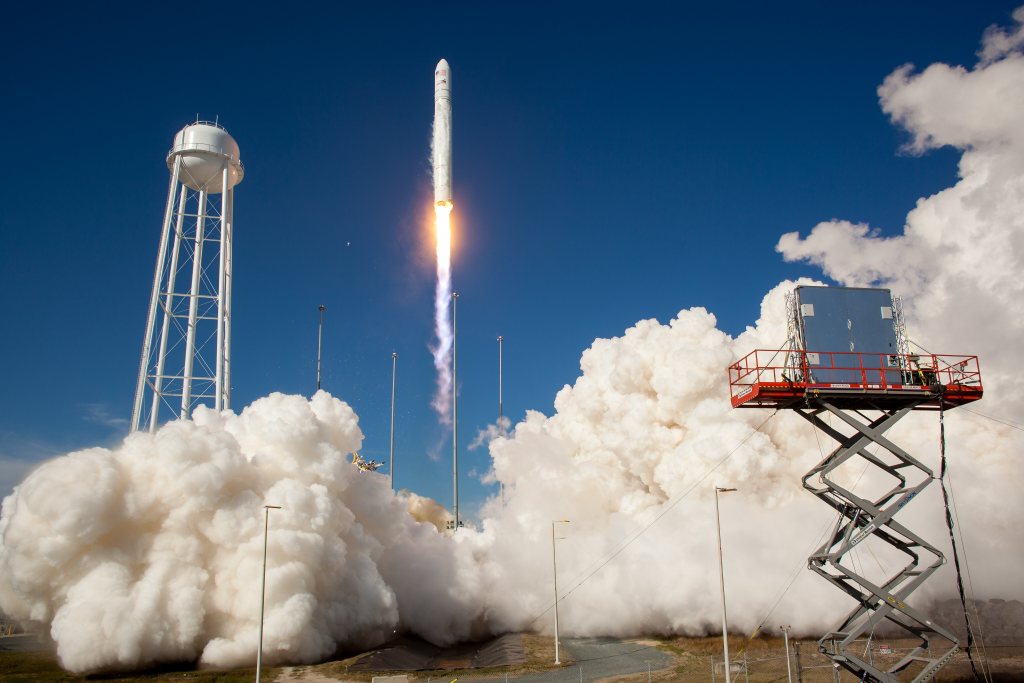Featured image credit: Austin DeSisto/Everyday Astronaut
Liftoff Time | August 2, 2023 – 00:31:14 UTC August 1, 2023 – 20:31:14 EDT |
|---|---|
Mission Name | NG-19, S.S. Laurel Clark |
Launch Provider | Northrop Grumman |
Customer | National Aeronautics and Aerospace Administration (NASA) |
Rocket | Antares 230+, the last one in the 200 series |
Launch Location | LP-0A, Wallops Flight Facility, in Virginia, USA |
Payload mass | 3,785 kg (8,344 lb) |
Where did the spacecraft go? | International Space Station (ISS); circular low-Earth orbit of ~415 km (~258 mi) in altitude, and ~51.6 degrees in inclination |
Did they attempt to recover the first stage? | No. That’s not a capability of the Antares 230+ |
Where did the first stage fall? | It fell to the Atlantic Ocean. |
Did they attempt to recover the fairings? | No. This is not a capability of the Antares 230+ |
Were these fairings new? | Yes |
This was the: | – Final launch of the Antares 200 series rocket – 1st Antares launch of 2023 – 8th launch of an Antares 230+ – 13th launch of an Antares 230 – 18th launch of an Antares – 1st successful twilight launch of Antares – 115th orbital launch attempt |
Where to watch | NASA replay Everyday Astronaut replay |
How Did It Go?
For the final time in its seven year history, the Antares 200 series rocket took to the skies in a beautiful display over the eastern United States. It lifted off from the MARS (Mid-Atlantic Regional Spaceport) Launch Pad 0A (LP-0A). After a few days of traveling to the ISS and slowly raising its orbit. At 12:28 UTC, the S.S. Laurel Clark Cygnus spacecraft successfully berthed to the ISS with the Canadarm2, delivering science and fresh food to the Expedition 69 crew. It will unberth from the ISS in October 2023.
It is typical for the Cygnus spacecraft to be named after previous notable individuals who worked in the space program, like astronauts or engineers. In this case, the Cygnus spacecraft is named the S.S. Laurel Clark after late Astronaut Laurel Clark who tragically died upon reentry to Earth’s atmosphere aboard the Space Shuttle Columbia in 2003 after completeing her scientific mission. She was a United States Navy doctor and diver, and a mother of one.
The naming of the NG-19 Cygnus spacecraft carries great honor for all, specifically Dan Tani whom we spoke with about the upcoming mission. Tani was in the same astronaut class as Clark. When discussing the significance of this mission for Tani, who’s been working with the Commercial Resupply Program (CRS) and Cygnus for years, he expressed that the alignment of the 10 year anniversary of Antares/Cygnus and the naming of the spacecraft after a dear friend is truly momentous.

What Is On NG-19 (S.S. Laurel Clark)?
The only way to get supplies up to the International Space Station (ISS) is by launching a spacecraft filled with cargo. It’s like going to the shopping mall in a car, where the car is our cargo ship. However, cars are much easier to operate than rockets and shopping malls are generally closer than the ISS.
Therefore, the cargo spacecraft must be filled to the brim with new experiments, replenishing supplies like food and water, as well as clothes and other necessities, and personal effects. Currently, there are three providers which can launch cargo. ROSCOSMOS with its Progress Soyuz vehicle, SpaceX with its Cargo Dragon vehicle, and of course, the Cygnus cargo vehicle.
Onboard NG-19 are 40 different scientific studies including human studies, experiments on fire safety, and experiments to improve life in space and on Earth.
Neuronix
Sponsored by the ISS National Lab, the Neuronix experiment is testing gene therapy to assist those with paralysis and other neurological diseases such as Alzheimer’s and Parkinson’s. Although there is no treatment for paralysis, researches have stated that gene threapy shows promise. The NG-19 Cygnus spacecraft will carry this experiment to the ISS where it will be conducted, simultaneously testing out the use of the ISS for drug testing of neurological disorders.

It may seem like this experiment should be conducted on Earth. However, the testing of different drug treatments must be done on 3D cell structures which are unable to form while under the influence of Earth gravity. Therefore, while under no aparent gravitational pull, the structures form and therefore the drugs can be tested.
Saffire-VI
NASA also likes to play with fire. More importantly, NASA and other space agencies need to have a deep understanding of how fire behaves in an environment where there is no apparent gravitational pull. By having a deep understanding, engineers and researchers can design systems to most effectively extinguish a fire in a worst-case-scenario.

In the last of a series of experiments, NG-19 will ferry the Saffire-VI experiment to the International Space Station. However, it will not be conducted while the vehicle is berthed to the ISS. A series of flammable materials, similar to what could catch fire on a space station, are laid out approximately a meter in length. Once set aflame, the speed and spread of the flame as well as the gases that are released will be studied.
Saffire-VI will be conducted after the Cygnus vehicle unberths from the ISS and is placed into a different orbit, in the case of an anomaly. By studying these characteristics, in combination with the five previous tests, researchers can better develop systems to extinguish and prevent such fires.
JAXA Art
In an effort to inspire the next generation of scientists, engineers, and researchers, the Japan Aerospace Exploration Agency (JAXA) has launched the I-Space Essay. The program is sending an SD card full of digital art works by over 13,000 students from 74 schools across Japan.

Other experiments include a new and upgraded water sanitation and dispenser system called Exploration PWD, which will replace the system currently on board, launched in 2008. Additionally, an atmospheric density measuring experiment, called the Multi Needle Langmuir Probe, will be launched. Also onboard Cygnus is a DUPLEX 6U CubeSat that will be deployed after Cygnus unberths from the ISS.
Cargo Mass Breakdown On NG-19
The following tables list only up-mass. However, when Cygnus finally leaves the station, it can take up to ~3,800 kg (~8,400 lb) of discarded items to burn upon reentry. Unberthing of NG-19 is planned to take place on NET October 30.
General
| Mass [kg (lb)] | |
|---|---|
| Total | 3,785 (8,344) |
| Pressurized [kg (lb)] | 3,749 (8,265) |
| Unpressurized [kg (lb)] | 36 (79) |
By Type
| Mass [kg (lb)] | |
|---|---|
| Crew Supplies | 1,590 (3,505) |
| Science Investigations | 1,128 (2,487) |
| Vehicle Hardware | 984 (2,089) |
| Spacewalk Equipment | 52 (115) |
| Computer Resources | 31 (68) |
What Is The Antares 230+?
Born out of the need for resupplying the ISS, the Antares 230+ is the latest iteration of an expendable medium-lift launch vehicle, which involves considerable international collaboration in both its development and manufacture. Specifically, the first stage derives from the Zenit rocket, with Ukrainian companies Yuzhnoye and Yuzhmash responsible for design and production, respectively. On the other hand, the engines in this stage are of Russian origin, with NPO Energomash providing them.

Finally, the second stage, the fairing, optional third stages, and avionics come from the United States. That is, Northrop Grumman is responsible for all of that, plus systems engineering, software, testing, and integration. Additionally, the Antares aims at providing responsive, cost-effective, and reliable access to orbit. For that reason, its design focuses on making use of flight-proven components.
The Antares 230+ comprises two stages in its 230 configuration, but optional third stages are available. Since its maiden flight on April 21, 2013, the Antares launch vehicles have seen action exclusively in boosting Cygnus spacecraft into space. However, the launcher’s design should allow even for sending payloads into Earth escape trajectories.
| Length [m (ft)] | ~43 (~141) |
| Diameter [m (ft)] | 3.9 (~13) |
| Liftoff mass [kg (lb)] | ~285,000 (~628,000) |
| Mass to LEO(1) [kg (lb)] | 8,000 (~17,500) |
| Mass to SSO(2) [kg (lb)] | 3,000 (~6,500) |
| Mass to Earth escape [kg (lb)] | 1,600 (~3,500) |
(1) 200 km (~124 mi) x 38°
(2) 500 km (~310 mi) x 98°

(credit: Northrop Grumman)
So far, this rocket has flown 17 times altogether, out of which one resulted in a failure. This represents a success rate of 94.12 %, which is neither impressive nor bad.
First Stage
As has been noted, Ukrainian enterprises provide the aluminum waffle structure core, and associated propellant feed systems. Furthermore, this stage features the RP-1 tank below the LOx one. Because of this, an oxygen downcomer pipe goes through the former tank, to let the oxidizer reach the engines. Further, pressurization tanks can be found inside the oxygen tank. At the lowest part of the first stage, there is a bay which houses both RD-181 engines and much of the needed piping.
| Length [m (ft)] | 27.6 (~91) |
| Diameter [m (ft)] | 3.9 (~13) |
| Engine | 2x RD-181 |
| Propellant | RP-1 and Liquid Oxygen (LOx) |
| Propellant mass, LOx [kg (lb)] RP-1 [kg (lb)] | 174,900 (~385,582) 64,400 (~141,975) |
| Thrust, SL [kN (lbf)] Vac [kN (lbf)] | 3,844 (~864,212) 4,170 (~937,406) |
| Isp SL [s] Vac [s] | 313 319 |
Supplied by NPO Energomash, the engines in the first stage run under a staged combustion cycle, particularly an oxygen-rich one. Moreover, their gimballing capability, for a total of 8°, enables first stage’s control in pitch, yaw, and roll. Conversely, the Antares 230+ relies on its cold nitrogen gas attitude control system (ACS) for coast phases before stage one separation. The RD-181s are also able to be throttled and has a mass of 2,200 kg (~4,850 lb) dry.
Second Stage
The external structure of the second stage encloses a Castor 30XL solid motor by Northrop Grumman. The latter features a composite graphite/epoxy case, as well as a flexseal at the nozzle’s throat, enabling gimballing. Consequently, the stage is capable of pitch and yaw control. The ACS is here, once more, responsible for coasting during this stage’s flight, as well as for roll control. Finally, a module installed on this stage provides the Antares 230+ with guidance. In order to do this, the vehicle implements Northrop Grumman’s Modular Avionics Control Hardware (MACH).
| Length(1) [m (ft)] | 6 (~20) |
| Diameter [m (ft)] | 3.9 (~13) |
| Motor | 1x Castor 30XL |
| Propellant | QDL-1(2) |
| Motor diameter [m (ft)] | 2.3 (~7.5) |
| Motor total mass [kg (lb)] | 26,453 (~58,318) |
| Propellant mass [kg (lb)] | 24,866 (~54,819) |
| Thrust Vac [kN (lbf)] | 557 (~125,229) |
| Isp Vac [s] | 296 |
| Burn time [s] | 155 |
(1) Motor’s length
(2) Hydroxyl-terminated polybutadiene (HTPB) polymer with 19 % of aluminum

Third Stages — Optional
Optionally, Antares 230+ rockets offer three different third stages, and as many extra configurations, as a result. Since the fairing is connected to the second stage, any of these upper stages consistently flies within the fairing. Configurations 232 and 233 achieve roll control by means of an ACS, as mentioned before.
Antares 231
In this case, an Orbit Adjust Module (OAM) featuring propulsion through monopropellant hydrazine increases the rocket’s performance. Eight Rocket Engine Assemblies (REA) generate 45 lbf (~200 N) of thrust each, as well as support relighting capability.
Antares 232
This configuration adds another solid motor: the STAR 48BV, with flexseal for thrust vector control around two axes (+/- 4°). Further, it features a titanium case holding TP-H-3340 solid propellant. In 232 configuration, the launcher becomes particularly suited for high energy orbits.
Antares 233
Yet another configuration that adds a solid rocket motor, e.i. the Orion 38. With a gimballing nozzle (+/- 5°), it uses QDL-1 solid propellant to boost the rocket’s performance to high energy orbits, as well as some LEOs.
Payload Fairing
Consisting of two halves, the in-house manufactured payload fairing is made of sandwich materials. That is, a honeycomb core and exterior composite facesheets. Frangible rail joints hold together both fairing halves, as well as attach the pair to the second stage. In order to achieve jettisoning, the joints are severed and pneumatic pistons push the halves open, while rotating on hinges.
| Length [m (ft)] | 9.9 (~130) |
| Mass [kg (lb)] | 972 (~2,150) |

The Path Leading To Antares 230+
The project kicked off back in 2007 when the company Orbital began its development. The following year, NASA would reassign an already awarded COTS contract, because of difficulties the original awardee experienced. Now it was Orbital which would benefit from it, continuing with its rocket’s development — Taurus II — and adding a spacecraft to resupply the ISS — Cygnus. Eight flights were awarded to Orbital under a CRS contract in 2008, though the first one should happen in 2011.
The Beginnings
Performance back then was in the range from 3,700 kg to 5,400 kg to LEO for the launch vehicle. The freighter capsule aimed at transporting 2,300 kg to the orbiting lab, with plans for a version that could return from space carrying 1,200 kg. The launcher was two-staged, with two NK-33 engines — staged combustion feats of engineering from the N1 times — rebranded as AJ26-62, in the first stage, and then a Castor 30 solid motor second stage. However, the latter was to experience an enhancement, allowing for 7,600 kg to LEO.
A series of tests took place in 2009, including that of the Castor 30, and of the NK-33. In the meantime, Wallops saw the construction of needed facilities for Antares operation. Later on, a pathfinder AJ26-62 went through testing at Stennis in 2010. During the next year, a serious mishap occurred with an AJ-26 engine. Better inspection protocols enabled it to continue ahead, in the end.
Already in 2010, there was talk of an enhancement for the second stage: either a methalox Pratt & Whitney Rocketdyne PWR35M engine, or a kerolox one, probably the RD-0120. In spite of this, in 2011 a more powerful Castor 30XL entered the plans, expecting to debut in the fifth flight. Additionally, there were mentions of an orbit raising kit (ORK), running on hypergolic bipropellants, and also of a STAR 48V solid motor, both as upper stages.
Antares
At the end of 2011, Orbital announced the renaming of their launch vehicle, once again choosing one that was a celestial name stemming from Greek culture. Antares is, in fact, the brightest star in the constellation Scorpius. Delays related to the launch site meant tests to the first stage needed to wait until 2012. Ending February 2013, a hot-fire test successfully took place.
On April 21, 2013, the second AJ-62-powered stage and the first Castor 30 stage, mated and carrying a dummy Cygnus, took to the sky. The inaugural Antares flight was a success. Later that year, the first live Cygnus saw its integration, and encapsulation. This was the second Antares 110 that rolled out to the pad, lifting off five days later. Completing four days of check-outs, and sorting out some issues, the spacecraft finally docked to the station some ten days after launching.
The third flight, on January 9, 2014, already featured an Antares 120, making use of a Castor 30B second stage motor. Its improvement materialized in a longer nozzle that increased its efficiency. After this flight’s success, an AJ26-62 failed during a static test fire, but the next launch and resupply mission was also completed nominally.
The Failure
In this case, it was the first Antares 130 to take flight, after two 110s and two 120s. The vehicle lifted off from Pad 0A at 22:22 UTC, on October 28, 2014, but fifteen seconds later an anomalous flame surged from the engine area. The rocket lost impulse, and fell to the ground, exploding spectacularly. Attention soon focused on the refurbished Russian NK-33 engines from the ’70s.
Initial clues pointed at a turbopump failure, and Orbital decided to discontinue the use of those first stage engines, as a result. Instead, two RD-181s would replace them, though down throttled to avoid damaging the old first stage structure. In the meantime, Cygnus would fly atop Atlas V launchers with as much as 35 % more payload. This increase would help alleviate the need of launching an extra mission to meet the resupply quota.
The Comeback
Two years after the failure, Orbital ATK’s new Antares 230 accelerated upward on October 17, 2016. Attempting to reach orbit, it carried the third enhanced Cygnus spacecraft, both stretched and more capable. Owing to the new power plant, the Antares launch vehicle gained about 20 % of payload capability.
Mid 2018, Northrop Grumman acquired Orbital ATK, right after the Antares 230+ improvement had been announced. Gathering experience from three successful flights of the 230 variant, the increased performance came as a consequence of structural design’s refinement of the first stage intertank and forward skirt, as well as Castor 30XL’s dry mass reduction.
Since its return to flight, the rocket has not seen failure, meeting NASA’s demand of hauling cargo to the space station up to the present.
What’s To Come
Facing the future, there are a number of doubts based on what is presently known. These arise from the Russian-Ukrainian conflict, which makes it impossible for Northrop Grumman to procure more first stages, or RD-181 for that matter. Therefore, it can not build any more Antares 230+ rockets as we know them.
The Interim
In the first place, the company has already purchased three flights on SpaceX’s Falcon 9. In this way, it ensures an uninterrupted flow of the needed provisions for the crews on orbit. In this case, how the Cygnus will be mated to the rocket, and if Falcon 9’s fairings will need redesign featuring pop-top options remains a mystery.
New Vehicles
On the other hand, Northrop Grumman has chosen Firefly Aerospace to continue the Antares legacy. That is, in a joint effort these companies are developing fully domestic first stages for the new variant: the Antares 330. It will be, however, identical to the 230+ from the second stage, and above. In communication with Everyday Astronaut, Northrop Grumman stated the new stages will also be used in the new medium-lift rocket in development: the MLV.
The new launcher’s design includes reusability, the company confirmed, while Antares 330 will remain expendable. Another key point about the MLV lies on its capability to carry the Cygnus spacecraft, as well as to satisfy the demand from other sectors: commercial, other NASA missions, and national security space launches.
In like fashion, facilities at Wallops should see a series of upgrades to accommodate future operations of these rockets. In response to our inquiry, Northrop Grumman explained teams have carried out some preliminary design, and also placed orders for hardware that takes longer to be ready. They have already installed a LOX tank, but most of the work will take place after NG-19, as the company clarified.
Both firms are working to debut the Antares 330 on schedule during mission NG-23, announced for NET June 2025. Everything hints at an exciting future, so far!
Antares Nomenclature
In order to understand the numbering convention in the name of this rocket, it is only necessary to remember that each digit refer to a different stage of the rocket. The following table should help in visualizing that:
| ID | Stage 1 | Stage 2 | Stage 3 |
|---|---|---|---|
| 110 | With 2x AJ26-62s | Castor 30 | None |
| 120 | With 2x AJ26-62s | Castor 30B | None |
| 121 | With 2x AJ26-62s | Castor 30B | BTS(1) |
| 122 | With 2x AJ26-62s | Castor 30B | STAR 48BV |
| 130 | With 2x AJ26-62s | Castor 30XL | None |
| 131 | With 2x AJ26-62s | Castor 30XL | BTS |
| 132 | With 2x AJ26-62s | Castor 30XL | STAR 48BV |
| 230 | With 2x RD-181s | Castor 30XL | None |
| 231 | With 2x RD-181s | Castor 30XL | OAM |
| 232 | With 2x RD-181s | Castor 30XL | STAR 48BV |
| 233 | With 2x RD-181s | Castor 30XL | Orion 38 |
| 330 | With 7x Mirandas | Castor 30XL | None |
NG-19 Mission’s Timeline
| Time* | Event | Altitude [km] | Altitude [mi] |
|---|---|---|---|
| 00:00.0 | Stage one ignition | 0.0 | 0.0 |
| 00:03.7 | Liftoff | 0.0 | 0.0 |
| 03:18.0 | Main engine cut-off (MECO) | 84.1 | 52.2 |
| 03:24.0 | Stage one separation | 89.1 | 55.3 |
| 03:54.0 | Fairing separation | 111.3 | 69.2 |
| 03:59.0 | Interstage separation | 114.3 | 71.0 |
| 04:07.0 | Stage two ignition | 118.5 | 73.6 |
| 06:49.0 | Stage two burnout/Orbit insertion | 172.9 | 107.4 |
| 08:49.0 | Payload separation | 172.6 | 107.2 |
What Is The Cygnus Spacecraft?
As has been mentioned, its development was the responsibility of Orbital (now Northrop Grumman) in order to fulfill a COTS contract with NASA. Presently, Northrop Grumman employs this maneuvering spacecraft to resupply the ISS, as agreed per CRS contracts. Under the first such contract, Cygnus hauled about 30,000 kg (~66,000 lb) of cargo to the ISS, with another 20,000 kg (~44,000 lb) expected when the second contract is completed.
Cygnus ships consist of a service module built in-house, while Thales Alenia from Italy provides the pressurized service module. Moreover, its propulsion system comes from GEOStar telecommunications satellites, with solar panels for the spacecraft to procure its electric power built by Northrop Grumman. It features an internal volume of 27m3 (~950 ft3), 6.39 m (~21 ft) in length, while it loads 800 kg (~1,760 lb) of propellants, with a total liftoff mass of up to 8,050 kg (17,700 lb)










